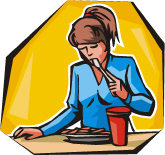 I remember the really hard times we had when my husband and I were young and starting out. Eating healthy really seemed like the bottom on our list of priorities because just scraping enough money together to put meals on our table for our 3 boys seemed like enough challenge.
I remember the really hard times we had when my husband and I were young and starting out. Eating healthy really seemed like the bottom on our list of priorities because just scraping enough money together to put meals on our table for our 3 boys seemed like enough challenge.
I also remember dreading each and every winter because it meant facing a lot of sickness and sleepless nights with a child throwing up or whining of an earache. I also never thought much about the deterioration of mine own health and that what we ate or didn’t eat was affecting us that much.
While it is true that fresh vegetables and eating wholesome seems to cost more, there’s the other side of the coin to consider that makes you realize how much less it really does cost.
Here’s some points to ponder on why eating healthy cost less:
1. As you begin to eliminate some of the “fast foods”, “convenience foods” and “processed foods” out of your diet, you end up spending much less. Most of processed foods have additives and unhealthy chemicals that deteriorate your health and actually cause you to crave more junk food. You can begin to eliminate most of this and save money as well by learning to make your own salad dressings, salsa, pancake syrup, yogurt and other condiments.
You can also make your own snacks and sweet treats which usually cost much less than the store. Plus, you’ll have more control over the amount of sugar that is used. I was shocked to learn that most of my recipes tasted just as pleasant with less sugar. (*Update: I now use stevia for making desserts at home.) I realize now that we’ve been consuming way too much sugar in our diet.
The key here is to progress slowly. You can get quite overwhelmed trying to make a huge change over night. Focus on a couple of new healthy recipes each month and learn to make just one more convenience item on your own. Then, establish a routine that allows you to keep stocked up on certain items. For instance, I make salsa every Thursday. This way, we can use the salsa for nachos on the weekend and any leftover salsa I can use for cooking in my recipes the following week.
2. After your body becomes accustomed to eating healthier, you’ll end up eating a lot less. Once your body becomes “nutritionally satisfied”, you’ll require a lot less food to feel satisfied. Those cravings to constantly eat will slowly vanish. How can you not save more money by eating way less?
For example: Snacking a just a small portion of nuts satisfies hunger far longer than potato chips, and nuts are better for you nutritionally. Fruit wards off hunger far better than any candy bar can.
Keep your kids from whining about food by setting limits on when they eat and how much they eat. Soon, they won’t be thinking about food all the time. And if your snacks are healthy, you won’t have to keep buying tons of snacks to keep them satisfied.
Popcorn is always a real winner. Save money by popping your own over the stove. You’ll be surprised how easy it really is. You’ll save lots of money eliminating the microwave bags and it’s much healthier for you without all the additives.
3. Eating healthy means being sick less often. Less visits to the doctor equal less stress, less time wasted in the doctor’s office, less money spent on co-pay and medicine. The healthier you and your family members are, you’ll reap more benefits that far outweigh the arguments that you can’t afford to eat healthy.
Some extra tips for eating healthy on a budget:
Watch for sales on frozen vegetables. These are healthier than canned vegetables in the long run because they retain their nutrients more, plus you’re not paying for all that extra sodium and water in the canned products.
Buy fruits and vegetables that are in season. You will usually find better sales on seasonal fruits and vegetables; therefore, plan your meals according to the season and what’s available at a decent price.
Buy produce by the bag, not by the piece if available. (Example: apples, grapefruit, onions, oranges, potatoes, etc.)
Don’t put junk food in your shopping cart. Eating junk food only adds to cravings for more junk food which wastes your money on food that doesn’t provide adequate nutrition. Make your own pudding, cookies and brownies and use less sugar (better yet, a natural sweetener). Another benefit of not having junk food within reach is that you will more than likely evaluate how bad you really need that sweet treat before you get into the kitchen to start baking since it takes some work.
Plan a few meatless meals during the week. Cut down on the amount of meat you buy. Most of us eat way more meat than we need to. Vegetable soups and salads can make terrific meals without meat. One idea is to cook meat one day and save the juices to flavor a vegetable soup the next day. To make your salads more hearty, chop up any small leftover meat scraps to toss in with your salad.
Drink water, almond milk or freshly squeezed juices instead of soft drinks: Drink almond milk or juice at breakfast and then drink water with the rest of your meals during the day. Buy 100% fruit juice instead of sugared drinks so that your body will be nutritionally satisfied from the vitamins in the juice. If you’re unwilling to give up sodas, you can try enjoying your favorite drinks only at a sporting event or night out.
Buy fruits in quantity: When they are in season, buy fruits in quantity and freeze any extras. You can buy several pounds this way, and freeze extras to have them when the fruit goes out of season. Wash the fruit well, remove any spoiled pieces, dry thoroughly, and then freeze in plastic zipper bags.
Choose chicken: Meats are good sources for protein and chicken is priced fairly reasonable. You can usually get 2 or 3 meals out of one chicken. Chicken can be mixed with pasta for a meal. You can also use cold chicken to create chicken salad sandwiches or simply chop some up to toss on a salad. Use the leftover carcass to create chicken stock to add to soups.
Get creative with beans: You can use beans as a substitute for meat. There are several varieties and you can find tons of bean recipes online. You can prepare them in a crock pot; so when you return home, they are ready to consume. (*Note: If you’re trying to lose weight, limit your carbs — as beans do have carbs… keep your fats low when cooking with beans.) If you experience gas after eating beans, you should try washing them, covering them with water, bringing the water to a boil. Then drain off the hot water and refill the pot with fresh.
Buy locally. Sometimes you can save money by buying fruits and vegetables locally. Honey and nuts are a couple of other items to consider buying locally. If you live in a coastal area or an area where you can fish, make that an integral part of your diet. You can catch them from the ocean, lakes, or rivers; saving money in the process.
Buy peanut butter in bulk. Peanut butter is great for those on a budget as it’s popular with almost everyone and helps ward off hunger. You can use it for sandwiches instead of eating hot dogs. Peanut butter also makes great cookies and goes well in banana shakes, etc. Bigger containers may need refrigeration since it can last you for weeks. (Side note: Look for a natural peanut butter without much added sugar, if possible.)
*Note: you can easily create your own peanut butter by processing peanuts in a food processor. Check out details and instructions here by click here.
Fill up on foods with high water content. Watch for sales on watermelon which make a great family treat. Salads and even gelatin are other examples on filling up on foods with extra water content.
Use rice and quinoa as fillers. Rice (and potatoes) are usually cheap and offer nutrition as well. Once again, you can utilize the internet to find lots of new recipes for these main ingredients. (Side note: If you’re trying to lose weight, limit rice and potatoes since they are high in carbs.)
Take time to measure. I find that measuring can be sort of an “inconvenience” when you’re in a hurry, but I also realized that I can really stretch my ingredients by taking time to measure. Figure out what least amount you can get by with on spices and seasonings and use that exact amount.
Be sure to measure items that are more costly. I measure my frozen blueberries in the morning for my breakfast. They’re a little costly to begin with, so I don’t want to just thoughtlessly toss them into my bowl in the mornings. I take time to measure out a small serving and overall this saves money by being cautious about the amount I use.
Plan your menus around the sales. Some people are big on menu planning, but rather than try to plan your menu and then shop for the necessary ingredients try finding out what’s on sale at the local market and then plan your weekly menu around that.

2 Comments
Jolene
Great article and SO true! I love living on the mission field because so many processed foods are unavailable to us. No cake mixes (brownies or cookies either), corn bread mixes, pancake mixes, bisquick, etc… We also don’t have canned soups, or anything else canned that is already prepared (such as baked beans)… or many, many other things. So, I am “forced” to make all of this myself… and we’re healthier because of it!
Also, I didn’t realize that the recommended amount of beans is 4 servings a week. Good thing my hubby grew up in Mexico, so we pretty much each a lot of beans anyway to keep him satisfied! (Good thing I love beans too, right?!)He’ll be glad to hear I learned this little tid-bit from you. 🙂
Rhonda
Thanks for stopping by to comment.
Here in the states I have access to a lot of “convenience” foods, but they’re not that good since they’re loaded with sodium and other chemicals.
To “force” myself to fix more on my own, I refrain from putting them in my cart.
If I do come across some really good sales on canned food that is mainly vegetables, I will stock up on them. Usually that is beans and tomato sauce, etc.
I don’t think one necessary needs to eat beans 4 times each week…it all depends on if you’re getting the nutrition you need from other foods. I do keep cans of black beans on hand because they’re handy to mix in with so many foods that I make such as soups and taco meat, etc. I simply wash them through a strainer to wash extra sodium off.